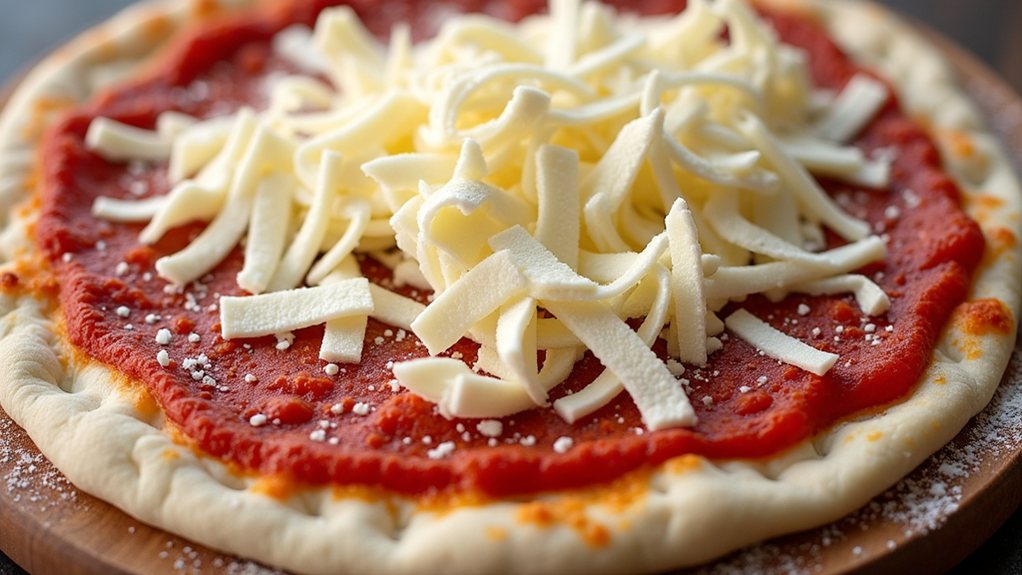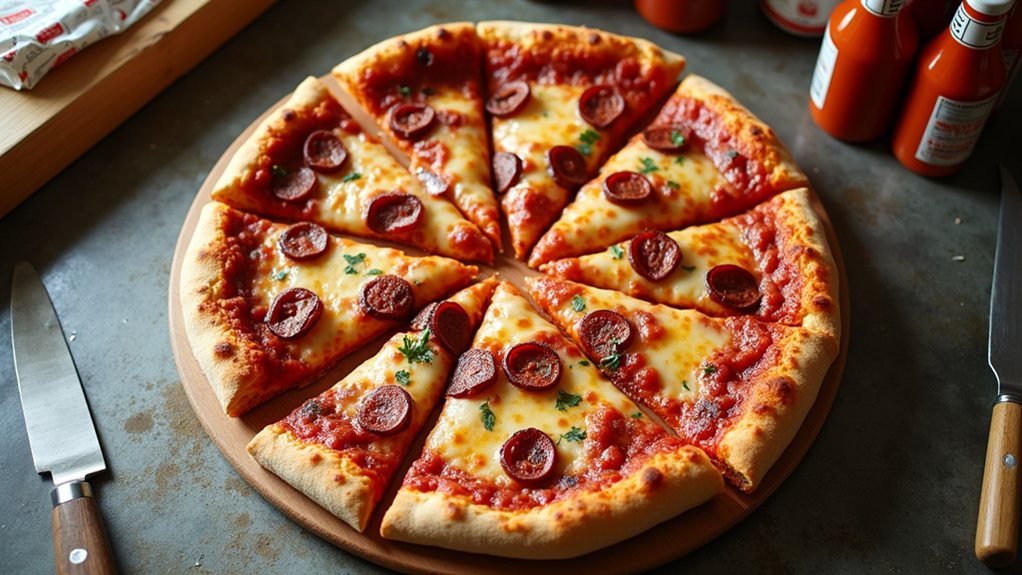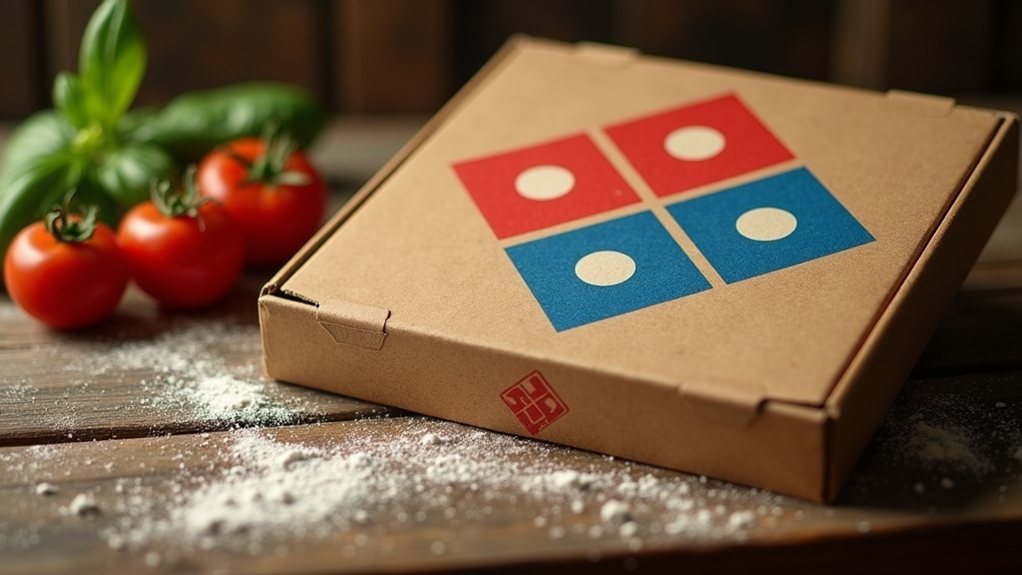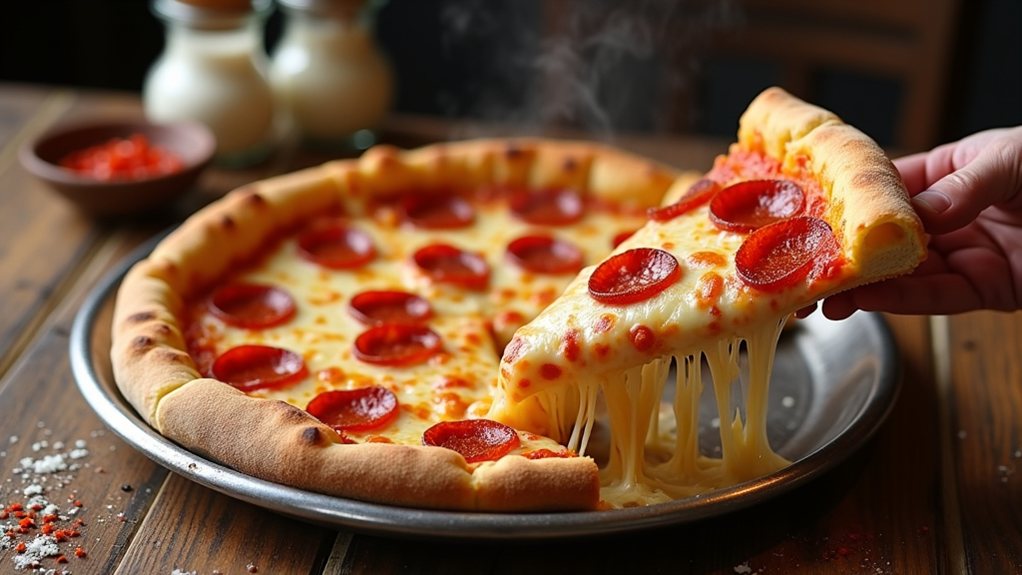The quest for perfect New York style pizza begins and ends with cheese selection, a detail that separates authentic pies from mere imitations. While many focus on dough or sauce techniques, experienced pizzaiolos understand that proper cheese blend and application create the characteristic stretch, flavor profile, and golden-brown spots that define a true New York slice. From corner pizzerias to acclaimed establishments, each venue guards its precise combination of cheeses as carefully as a family heirloom.
Understanding Low Moisture Mozzarella
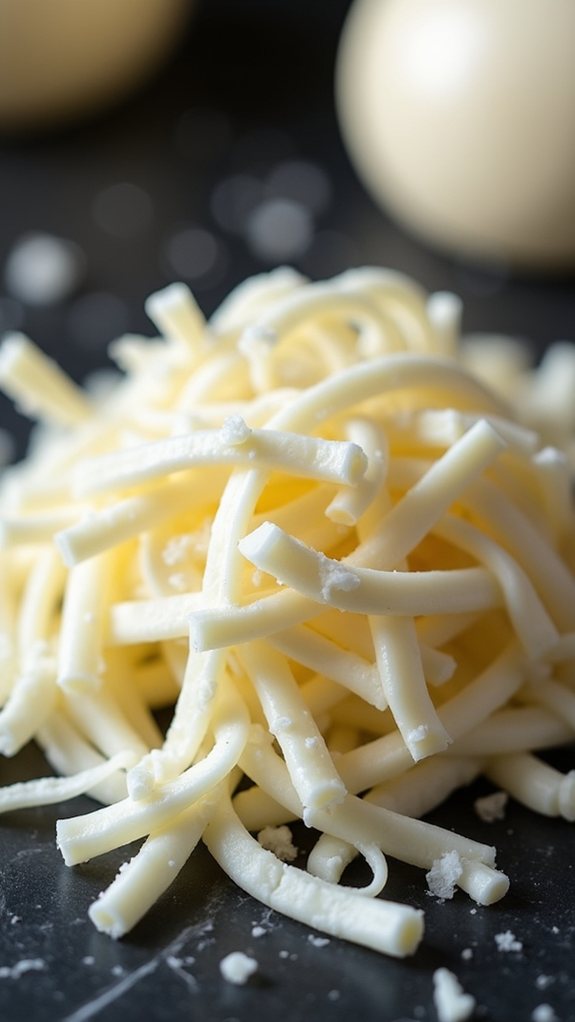
Low moisture mozzarella stands as the foundation of authentic New York style pizza, distinguished by its firm texture and superior melting properties.
Whole milk varieties deliver richer flavor profiles compared to part-skim options, though they tend to release more oil during baking.
Pre-shredded versions should be avoided due to anti-caking agents that compromise the cheese's natural melting characteristics.
While part-skim mozzarella produces less separation and grease, it sacrifices the depth of flavor that makes New York pizza memorable.
The choice between whole milk and part-skim often represents a balance between achieving ideal flavor and managing the pizza's grease factor.
For enhanced complexity, some pizzerias incorporate small amounts of aged Parmesan cheese to add nutty, umami-rich notes to the overall flavor profile.
The Whole Milk Vs Part Skim Debate

When selecting mozzarella for New York style pizza, the choice between whole milk and part-skim varieties creates a notable fork in the road for pizza makers.
For pizza artisans crafting authentic New York pies, choosing between whole milk and part-skim mozzarella becomes a crucial decision point.
Testing reveals that whole milk mozzarella delivers superior flavor and richness, though it tends to separate more oils during baking.
Part-skim options, while producing less greasy results, sacrifice the depth of flavor that makes New York pizza memorable.
A recent comparison demonstrated that even a 50/50 blend exhibited similar greasiness to full-fat versions, while pure part-skim cheese yielded noticeably inferior taste, suggesting that compromising on fat content may not be worth the trade-off.
For optimal cheese performance, pair your mozzarella choice with Tipo 00 flour to achieve that coveted crispy-yet-tender crust texture.
Secret Cheese Blends of Famous Pizzerias

Many legendary New York pizzerias guard their cheese blends as closely as bank vaults protect their assets, with establishments like Scars Pizza famously using a proprietary mix of three distinct cheeses.
While most pizzerias rely primarily on low-moisture mozzarella as their base, many improve their signature taste by incorporating precisely measured amounts of Pecorino Romano or Parmigiano-Reggiano.
These carefully crafted combinations create depth of flavor that distinguishes exceptional pizzas from ordinary ones.
Some establishments have even experimented with craft cheese sticks and specialty blends from suppliers like Gordon Food Service, though traditional whole milk mozzarella remains the gold standard.
The thin foldable crust has become synonymous with authentic New York-style pizza, allowing the carefully selected cheese and sauce to shine through.
Enhancing Flavor With Hard Italian Cheeses
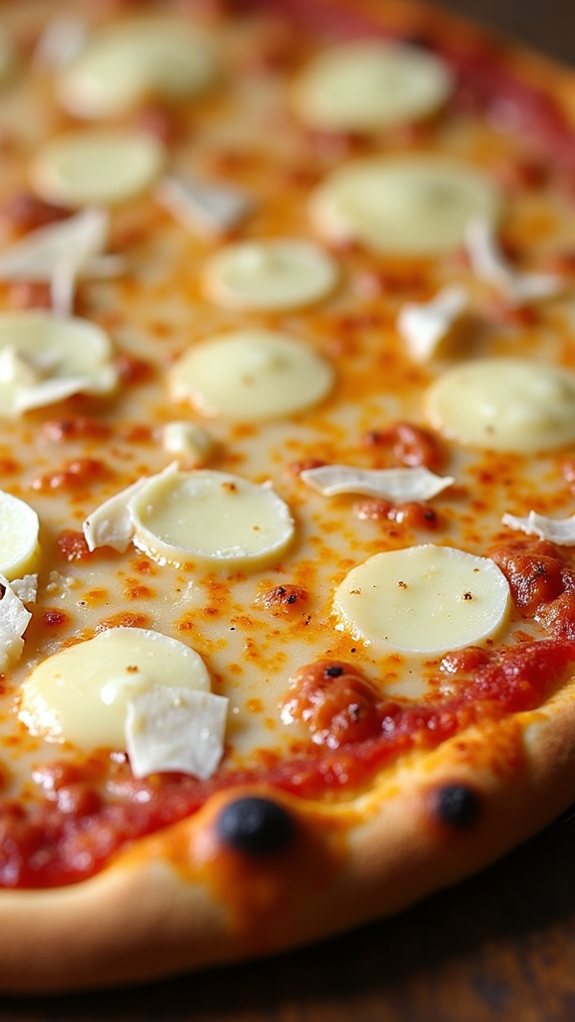
Since mozzarella provides a relatively mild flavor profile, experienced pizzaiolos often enhance their New York style pizzas with hard Italian cheeses like Parmigiano-Reggiano and Pecorino Romano.
These aged cheeses introduce complex savory notes that improve the overall taste experience.
- Parmigiano adds rich, nutty undertones with natural salt crystals
- Pecorino Romano delivers sharp, tangy characteristics
- Light dusting before baking creates subtle depth
- Post-bake sprinkling amplifies aromatics
While craft Parmesan can provide basic saltiness, authentic Italian hard cheeses offer superior depth and complexity.
Testing has shown that Pecorino Romano achieves an ideal balance of saltiness and tang, making it a preferred choice among discerning pizza makers.
Texture and Cooling Characteristics
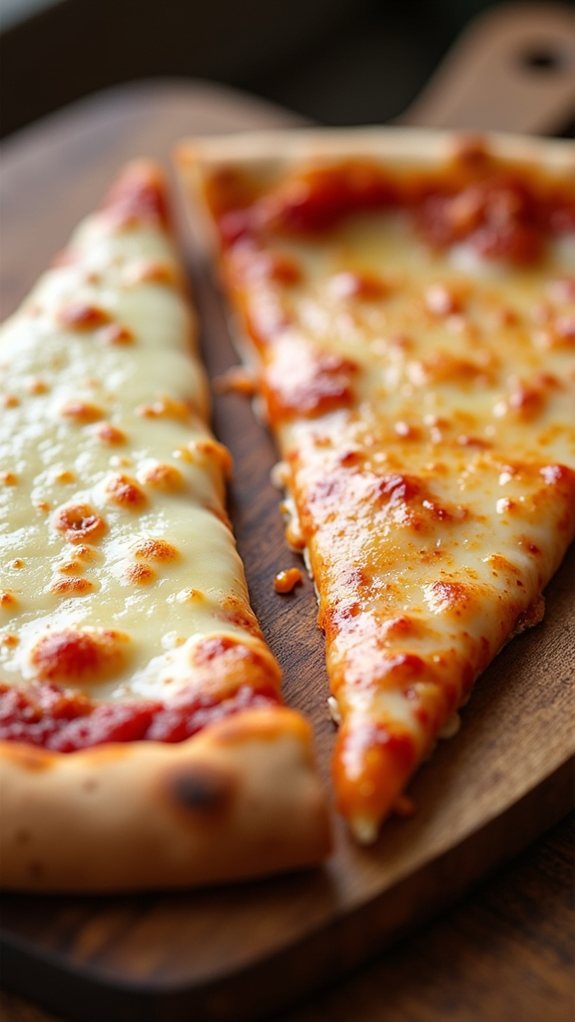
The texture of New York style pizza cheese undergoes notable changes as the temperature drops, revealing crucial differences between different mozzarella options.
Whole milk mozzarella maintains a creamier consistency but shows more pronounced grease separation, while part-skim varieties become noticeably rubbery and stringy upon cooling.
Testing revealed that Gordon Foods cheese offered superior texture retention compared to traditional options, though Grande Cheese, despite its popularity in New York pizzerias, produced a greasier result than desired.
The cooling process particularly highlighted these variations, with the original cheese samples developing an undesirable rubbery characteristic that affected the comprehensive eating experience.
Avoiding Common Cheese Pitfalls
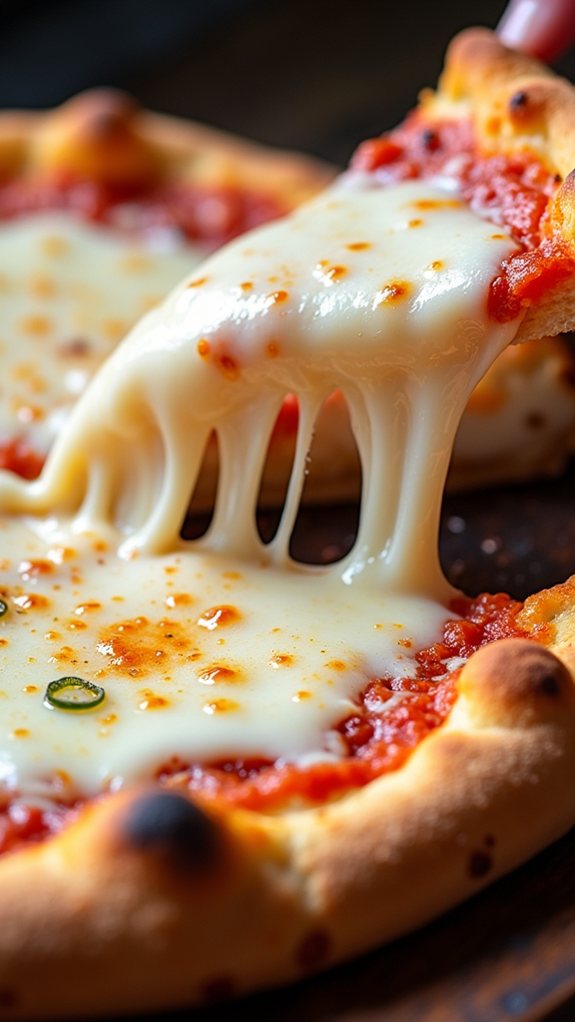
Understanding cheese-related mishaps can mean the difference between a mediocre and magnificent New York style pizza. When crafting the perfect pie, several common pitfalls can derail your quest for authenticity, but knowledge is power in terms of cheese selection and application.
- Pre-shredded cheese contains anti-caking agents that interfere with proper melting.
- Using exclusively part-skim mozzarella results in compromised flavor depth.
- Incorrect cheese-to-sauce ratios lead to unbalanced taste profiles.
- Poor quality Parmesan or Pecorino additions can mask rather than improve flavors.
The key to cheese success lies in choosing whole milk low moisture mozzarella, while avoiding processed alternatives that promise convenience but deliver disappointment.
Best Cheese Practices for Home Pizza Making
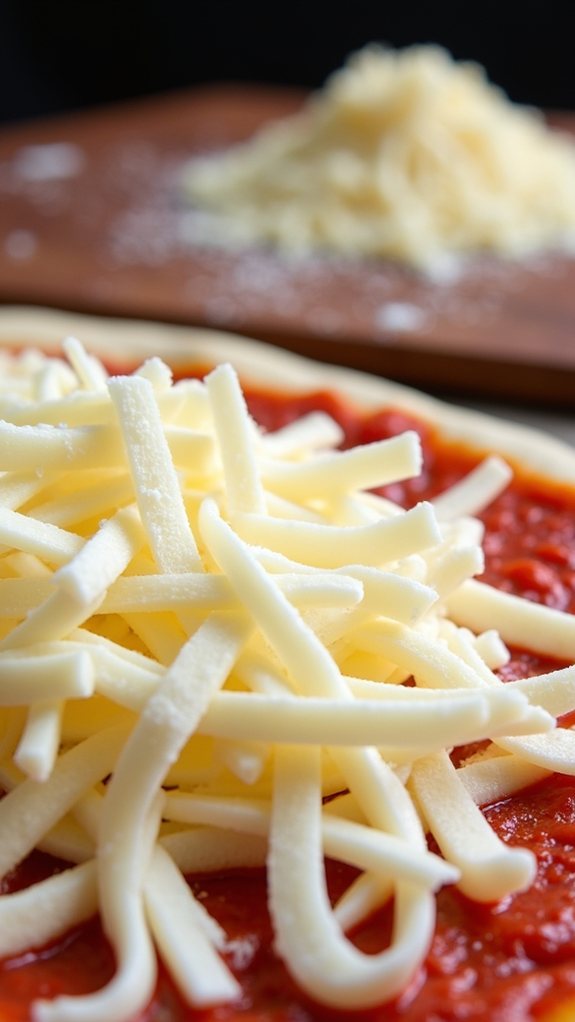
Creating superior New York style pizza at home demands mastery of proper cheese techniques, which professional pizzerias have refined through decades of experience.
For ideal results, select high-quality whole milk low moisture mozzarella and avoid pre-shredded varieties containing anti-caking agents. While part-skim options reduce greasiness, they compromise vital flavor components that define authentic New York pizza.
To improve taste complexity, incorporate a light dusting of Pecorino or Parmigiano, focusing on even distribution across the surface.
When experimenting with cheese blends, keep in mind that a 50/50 mix of whole and part-skim mozzarella offers minimal grease reduction while greatly sacrificing the rich, characteristic flavor that makes New York pizza legendary.
FAQs
Can Vegetarian Alternatives Achieve the Same Texture as Traditional Mozzarella Cheese?
Plant-based cheese alternatives can approximate mozzarella's texture, but most struggle to achieve identical melting properties and stretchy consistency. Some cashew-based options come closest to replicating traditional mozzarella's characteristics.
How Long Can Pizza Cheese Be Safely Stored in the Refrigerator?
Properly stored mozzarella cheese remains safe for 2-3 weeks when refrigerated. Block cheese lasts longer than shredded varieties. Once opened, consuming within 5-7 days guarantees peak freshness and quality.
Does Altitude Affect How Cheese Melts on New York Style Pizza?
Altitude affects cheese melting due to lower air pressure and temperatures at higher elevations. Pizza makers should adjust cooking temperatures and times to achieve proper melting and browning characteristics.
What Temperature Should Cheese Reach Before Shredding for Optimal Results?
Cheese should reach approximately 40°F (4°C) before shredding, as this temperature provides enough firmness for clean cuts while preventing the cheese from becoming too soft or sticky.
Why Does Cheese Sometimes Develop a Bitter Taste After Reheating Pizza?
Like milk left too long in sunlight, cheese becomes bitter when reheated due to proteins breaking down and oxidation occurring. Higher-fat mozzarella is particularly susceptible to this chemical transformation during multiple heat cycles.
